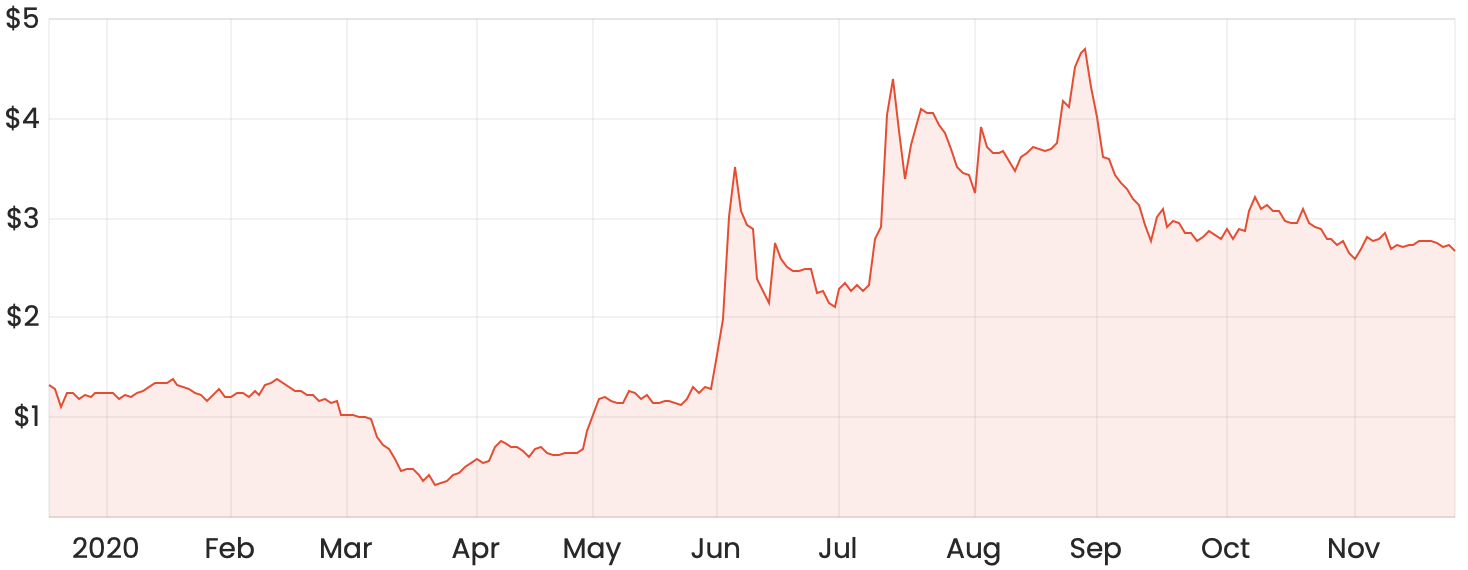The Openpay Group Ltd (ASX: OPY) share price has pulled back around 40% from its August high this year. Have shares now entered buying territory?
Openpay is one of a growing list of buy now, pay later (BNPL) providers on the ASX. Some of Openpay’s larger merchants include Kogan.com Ltd (ASX: KGN) and Bunnings Warehouse, a subsidiary of Wesfarmers Ltd (ASX: WES).
OPY share price chart

Openpay’s BNPL business model
Openpay allows customers to purchases products valued up to $20,000 from its merchant partners and spread the repayments across 2-24 months. This represents a higher purchase limit and longer repayment duration than many other BNPL providers such as Afterpay Ltd (ASX: APT) and Sezzle Inc (ASX: SZL).
Customers are required to make the first payment on the day of the purchase, with the rest paid in instalments on a weekly or fortnightly basis. Openpay does not charge ‘interest’ but may charge plan establishment, plan management redraw, default and referral fees.
Plan management and application fees vary by merchant. As an example, according to Openpay’s dedicated Bunnings webpage, for purchases under $1,000 customers pay a plan management fee of $0.50 each time they make a repayment. For purchases above $1,000, an application fee of $25 and an ongoing management fee of $2.50 is charged.
Openpay’s terms and conditions state a default fee of $9.50 is payable if a payment is not made on the due date. A further referral fee of $19.50 is also payable if an instalment is still unpaid eight days later.
Merchants receive the value of the purchases less a fee calculated as a percentage of the transaction value. Openpay does not openly state this percentage, however, merchant fees represented around 4.3% of FY20 total transaction value.
Openpay’s point of difference
In addition to Openpay’s BNPL offering, the company also offers a business-to-business (B2B) software-as-a-service (SaaS) platform.
The B2B platform offers businesses an end-to-end solution for the digitisation and management of business customer accounts. Features include account application and setup, transacting, statements and invoices, and account reconciliation.
In February this year, Openpay signed Woolworths Group Ltd (ASX: WOW) onto its B2B platform. Openpay CEO Michael Eidel commented: “We’re excited to launch Openpay For Business with an Australian business as iconic as Woolworths. This new SaaS product represents an important differentiator for us. It does not require support from Openpay’s balance sheet and is expected to deliver diversified revenue streams for the Company.”
Openpay has flagged its intention to roll out the platform within Australia and globally.
Recent trading update
At Openpay’s November annual general meeting (AGM), the company provided updates on how its BNPL and B2B offerings are tracking.
Openpay advised that compared to the prior year, active plans surged 233% to 1.15 million, active customers jumped 143% to 390,000 and active merchants lifted 34% to 2,346.
In October alone, total transaction value (TTV) reached $25.8 million, representing a 101% increase compared to the prior corresponding period.
Openpay was pleased to record strong underlying metrics in the first quarter of FY21, including net transaction margin of 2.2%, net bad debt rate of 1.6% of TTV, and a “market-leading” gross revenue yield of 9.1%.
Openpay also highlighted strong growth in its UK BNPL offering. To date, 50 UK retailers have agreed to offer Openpay’s payment solution at the checkout, including large retailers JD Sport and The Hut Group. As at October 2020, Openpay had 337,000 active plans and 162,000 active customers in the UK.
Openpay also advised its B2B platform went live with Woolworths in September. This marked the first revenues generated by the product. Other leading retailers have reportedly expressed interest in the B2B solution.
Is the Openpay share price a buy?
While the Openpay share price is well off its highs, I am unsure if Openpay is a business I would want to own shares in. Although the company’s BNPL product is slightly different from those of its competitors, it is not unique.
Additionally, some of the recent customer reviews for Openpay I have seen on Trustpilot and ProductReview are quite negative. In fact, many are warning others to stay away from it.
I do think Openpay’s B2B platform sounds promising, however, just one customer (Woolworths) has signed on to date. I would need to see a turnaround in customer feedback and growth in Openpay’s B2B customers before considering buying shares.








